


The fourth annual TCC Meeting, at the source of our passion, was a resounding success. The field trips, lectures, show and sale, and facilities were exceptional. Despite the long distance to travel, 56 members attended the meeting. We all seconded Peg Sutor’s comments at the board meeting thanking David Hoexter and Judie Siddall for planning and organizing the meeting. It was a perfect mix of activities and locale.
Thursday, October 9
The meeting opened with welcoming remarks from David and Judie. Robert Copeland, the quintessential British gentleman, then gave an informative historical lecture. In discussing the evolution of the potteries, he explained that crude earthenware was produced all over England from 1530 to 1630 in “one man potteries.” The potters in Staffordshire used the natural red clay of the area. The early potteries developed from farms as it became clear that pottery was more profitable than farming. The concentration of potteries in Staffordshire was primarily due to the abundance of local coal for fueling the kilns. The potteries continuously experimented with the clay, attempting to make whiter wares. In 1710, adding sand to the clay and salt to the glaze, whiter pieces were made. In 1720, China clay (kaolin) was transported from Devon and Dorset making yet whiter wares. Staffordshire potteries still use China clay from this area. The 1750s saw the first attempts to make porcelain. The process was perfected over time and resulted in the manufacture of fine porcelain by Spode in 1800. In the 1840s, cattle shin and knuckle bone added to the clay made fine “bone” china. The potteries also experimented with techniques to shape and decorate the pots. In 1670, slip decoration involved using clay of a different color to decorate the pots. In the 1700s, lathes and plaster of Paris molds were introduced. In 1754, cobalt imported from Saxony was rubbed into a pattern scratched into the clay. Bat printing was introduced in 1750s and, our favorite, transfer printing was introduced in the 1770s.
Friday, October 10
Friday morning we toured the Spode factory and followed the pottery making process from clay ball to the decorated pot. We saw manual and automated methods of forming clay for earthenware and porcelain pieces. We observed several ways of decorating pieces, including the traditional transfer process, the application of decal patterns, hand painting, and an automated paint transfer process. We learned that only approximately 10% of the current Spode production is by the traditional transfer process. One of the more interesting parts of the tour was the demonstration of copper plate engraving. The young man demonstrating the process explained that the depth of the etching in the surface of the copper determines the intensity of the color transferred. Depending on the complexity of the pattern, it can take up to nine weeks to complete an engraving. The engraved plates can be used repeatedly and some types of damage to them can be repaired. The apprenticeship for an engraver is four years. The pieces ready to be fired are placed on clay shelving situated between two tracks on the floor. The kilns move on the tracks over the shelving for firing and can be loaded or unloaded from either end. A striking contrast to old firing processes and conditions. A highlight of the tour was viewing the Blue Room with Robert Copeland. This museum area is not included in the usual tour. He spoke proudly about the display of blue wares produced by Spode over the years. The oldest pieces of Spode chinoiserie transferware were placed next to the hand painted Chinese pieces from which they were copied.
After lunch at Spode, we traveled to the preserved site of the Cheddleton Flint Mill. Flint was an absolute necessity for the potters. Flint rock from the beaches of the English Channel was brought here via rivers and canals. The rock was fired in ovens at the site then moved into the mill where it was ground. Two water wheels, supplied by a nearby river, powered the mill’s machinery. A demonstration proved the system still worked. The Cheddleton site included a canal, canal boats, ovens, water wheels, mills housing the machinery for processing the flint and a miller’s cottage.
Friday evening we enjoyed lectures by the Holdaways. Minnie showed slides and discussed the use of small blue and white pieces. Some of the more unusual pieces shown were asparagus trays, plate lifters or tippers put under plates to help the juices run to the edge of the plate, and window rests used to hold windows open. We also learned that egg drainers are used to take eggs out of the water after boiling.
Tim spoke about four sources, related to the sporting life, used for ceramic design. He showed slides of source prints and their transferware counterparts. The sources were published between 1791 and 1812 and included Rural Sports by William B. Daniels and General History of the Quadrupeds by Thomas Bewick, (pronounced “Buick”). The vignettes used in the latter book were the sources used on the pottery. Did the sukotarius really exist?
Saturday, October 11
Saturday morning we visited the Potteries Museum and Art Gallery. The museum contains one of the finest collections of British ceramics from the Middle Ages to the late 20th century. Miranda Goodby, Keeper of Ceramics, provided a guided tour of the part of the collection most appealing to us. It was particularly interesting to see pieces of the earliest Staffordshire red clay earthenware from 1660-1747. Most of these pieces were functional cooking and serving ware. Some were slip decorated. The most famous piece of slipware, prominently displayed, is “Ozzie the Owl” which was discovered on the Antiques Road Show and purchased by the museum. We saw pieces of salt-glazed stoneware, creamware, porcelain, and bone china; transferware was included among these pieces. We also saw exhibits on Wedgwood and Minton factory wares. Miranda explained that when Minton’s was purchased by Royal Doulton, Royal Doulton did not accept the museum’s offer to buy the Minton historical collection. Instead they put the collection up for auction; the museum was able to purchase 40 of the approximately 200 pieces at auction. The pieces are on display at the museum and are quite impressive. They include a large peacock and several large pieces of majolica earthenware.
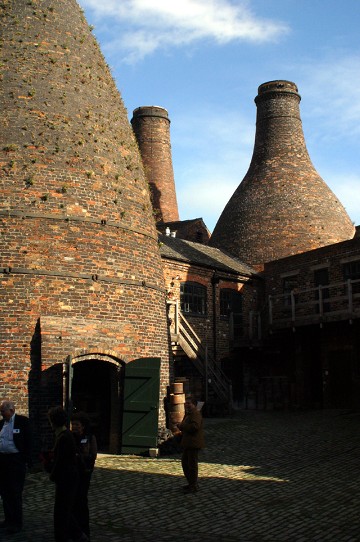
After lunch at the Potteries Museum our coach took us to the Gladstone Pottery Museum, Longton, the preserved site of the old Gladstone Pottery works started at the end of the 18th century. Touring the site one imagined the old pottery manufacturing process and difficult working conditions. The tour included the buildings where the clay was formed into pots sometimes using a lathe, a room for storing molds, the color mixing room, the pottery decorating room, and the doctor’s office and examination room. There were also demonstrations of modern pot throwing and making flowers from clay, the latter a process that cannot be automated. The most fascinating part of the tour was seeing and entering the bottle ovens, a characteristic feature of the old potteries. The inner part of the oven is a round room with a domed roof, foot thick walls, and a door just large enough for workers carrying saggars on their heads to enter and stack the saggars. The saggar is a clay box that holds the pottery pieces and powdered flint or silica sand glazes during firing. Outside, around the base of the oven, are firemouths in which coal fires were lit. The fireman controlled the firing process that took three days and reached temperatures of 1000-1250 C. The excessive heat and exposure to flint and silica powders made for adverse working conditions for the pottery workers, not to mention the air pollution that affected the rest of the population.
That evening we heard lectures from another husband and wife team. David Barker, an archaeologist with the Stoke-on-Trent government and husband of Miranda Goodby, spoke about “Archaeology in the Staffordshire Potteries.” In the last 20 years, archaeology has made a major contribution to the study of the potteries. At its peak, the Stoke-on-Trent area had over 150 potteries and employed approximately 30,000 people. Mr. Barker’s office works with construction companies and highway departments to set up excavation sites to gather evidence before it is destroyed by construction. Sometimes this collaboration is not easy. One of the several excavation sites he spoke about was a road construction project that extended through twenty-seven 19th century pottery sites. Transferware shards “by the sackful” were found, as well as pot lids and pharmaceutical wares. Structural evidence of the potteries, (e.g., the bottle ovens) was also found, but information from structural evidence is limited. The “bread and butter” finds of a dig are the pottery wasters, discarded material, which provides evidence about items ordinary people used, how they used them, and why they were discarded. His office currently has many more excavation projects planned. For more information, contact the office website at www.stoke.gov.uk/archaeology.
Ms. Goodby spoke about the relationship between “Potters and Publicans.” From the late 17th century, the potteries made drinking vessels and tavern wares including puzzle jugs, punch bowls/pots, and mugs for the public houses (taverns and inns). By 1834, there were 82 taverns and 36 inns in Staffordshire. Some of the taverns were within potteries. The pottery manufacturers owned most of the inns. Adverse working conditions may have contributed to excess alcohol consumption by the workers. Drinking on the job was common. Women and children workers also drank alcohol. If alcohol consumption affected a workers production quota early in a week, the work had to be made up by the end of the week. After 1850, water safe to drink was piped to the towns providing an alternative to alcohol.
Sunday, October 12
Sunday morning David Hoexter conducted the TCC meeting. Peter Bevacqua reported that many election ballots had already been returned to him and that he would report the results as soon as tabulated. Chet Creutzberg reported that the financial status of the club remains sound. Judie Siddall reported that the club has lost members and encouraged current members to make a concerted effort to recruit new members. Dennis Berard reported that the next TCC annual meeting is scheduled for October 1-3, 2004, at Sturbridge Village in Sturbridge, MA.
Following the business meeting, Geoffrey Priestman reviewed some history of the Minton pottery as documented in his book An Illustrated Guide to Minton Printed Pottery 1796-1836. In 1780, Thomas Minton was an apprentice engraver for Caughley. He later worked as an engraver for Spode and other potteries until he started Pottery Works in 1793. To conduct his investigation of the Minton pottery, Mr. Priestman used archival evidence (e.g., sales accounts, copper plates, source prints pasted in scrap books, and pattern books) to identify early patterns and examined examples of ware to enable identification of characteristic marks, shapes, and styles. This methodology led to the identification of additional Minton patterns. His presentation included slides of Minton chinoiserie patterns from 1796-1820, European landscapes and floral patterns from 1820-1825, and Romantic patterns from 1825-1836.
Our final speaker was the well known Richard K. Henrywood author with the late A.W. Coysh of The Dictionary of Blue & White Printed Pottery 1780-1880 Volumes I and II. Mr. Henrywood identified three periods of blue and white underglaze printed pottery and patterns, but focused on the Vintage period from 1810-1835, during which the “pieces we love so well” were made. Middle class business people, who aspired to travel, used the ware. Therefore, the patterns included foreign views copied from travel books as views from India, the South of France, Great Britain, and America. Additional patterns of this period were genre scenes of everyday life in the countryside and botanical patterns. Mr. Henrywood is considering the following changes to the next edition of the dictionary: inclusion of colors other than blue and white from the 1830s forward; and inclusion of a section on interesting pieces. TCC members are invited to make suggestions for improvements to the Dictionaries. Contact Dick Henrywood via the email address published in the Winter 2003-2004 TCC Bulletin.
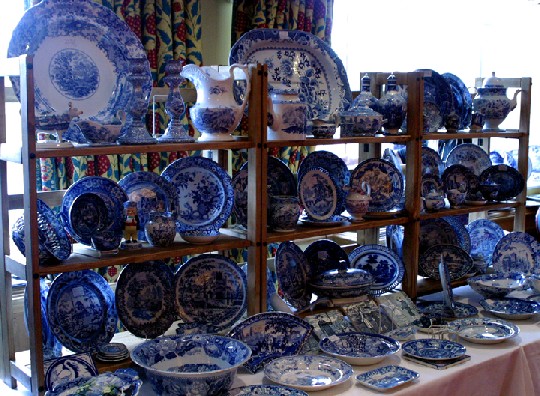
The meeting concluded with the much anticipated show and sale. Again, the show was outstanding. Seven British vendors and one TCC member brought lots of pieces, predominantly blue and white, to view, discuss, and purchase.
Thanks to all who helped to make the meeting happen, including David Hoexter, Judie Siddall, Robert Copeland, Peter Scott, Chet Creutzburg, Diane and Ward Zumsteg, Dina and Andrew Zuger. A special thanks to our British members, speakers, and vendors for your hospitality and contribution to a successful meeting.
Rich with content for ceramic collectors, researchers, authors, curators, and historic archaeologists, the sites are sure to deliver value for their visitors. The exhibition’s curators continue to enhance them and, now, with site application upgrades, including a new magnification feature and upgraded content management capabilities, the TCC and its collaborators are pleased to relaunch these exhibits, all free to a worldwide audience.
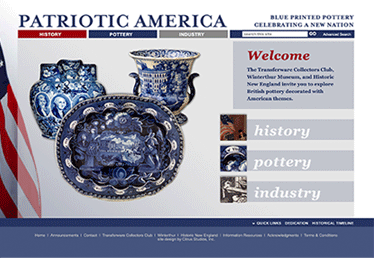
Branded Patriotic America, debuted in 2014 in collaboration with Historic New England, and the Winterthur Museum
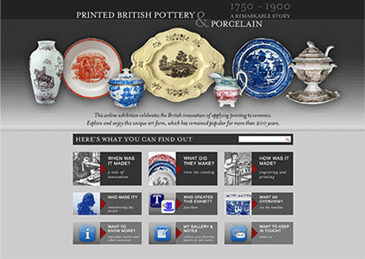
Launched in 2015 in partnership with the Northern Ceramic Society.
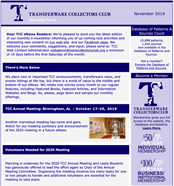 Not a member but want to receive email updates?
Not a member but want to receive email updates?